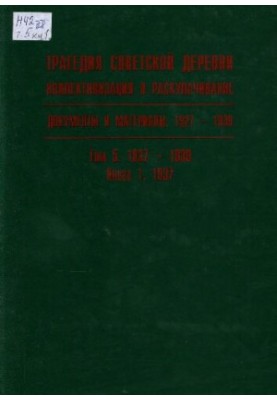The Tragedy of the Soviet Village. Collectivization and Dekulakization. 1927-1939. In 5 vol. 5. 1937-1939. Book 1. 1937
 Instant download
Instant download
after payment (24/7)
 Wide range of formats
Wide range of formats
(for all gadgets)
 Full book
Full book
(including for Apple and Android)
The Tragedy of the Soviet Village . Collectivization and dekulakization. 1927-1939. In 5 t. T. 5. 1937-1939. Kn. 1. 1937" is a unique and in-depth study of one of the most dramatic periods in the history of the Soviet Union, revealing the tragic pages of collectivization and dekulakization on the example of concrete events of 1937. The author, whose name remains unknown, created a work that not only immerses the reader in the atmosphere of the era, but also reveals the complex mechanisms of political repression, social upheaval and human dramas associated with the transformation of rural areas. This book is part of a large-scale five-volume study devoted to the period from 1927 to 1939, and is particularly notable for its detailed study of the events of 1937, when a wave of repression unfolded in the Soviet Union, covering millions of people. In the first volume of the fifth section, the author analyzes in detail the causes, course and consequences of dekulakization - a cruel campaign to seize property from peasant kulaks, which became one of the symbols of Stalin's repressions. The focus is on the fate of ordinary people, their fears, hopes and despair, as well as the mechanisms of coercion and violence used by the Soviet government. The book is especially valuable for those who are interested in the history of the Soviet period, social conflicts, political repression and the fate of the peasantry. It will suit both students and historians, as well as a wide range of readers who want to understand the causes and consequences of large-scale social upheavals that forever changed the face of the Soviet village. This work will not leave indifferent those who seek the truth about the tragedies of the era, about people caught in the center of political games and repressive mechanisms. The author's style is distinguished by analytical depth, attention to detail and the ability to convey the atmosphere of time. The book uses unique archival materials, eyewitness accounts and documents, which makes it not only a scientific work, but also a living story about human fates. The author masterfully combines facts and emotional storytelling, creating a vivid picture of events that makes you think about the price of human life and how public policy can destroy the fate of millions. A special place in the book is devoted to the topic of collectivization, a process that has become a catalyst for social change and tragedy. The author shows how ideas about transforming agriculture turned into a large-scale campaign of violence, and how it affected rural life, destroying traditional ways of life and causing a massive split within society. Attention is paid not only to the political aspects, but also to the psychological experiences of the peasants, their struggle for survival and the preservation of human dignity. If you appreciate a deep historical analysis, rich in details and living evidence, then “The tragedy of the Soviet village . Collectivization and dekulakization. 1927-1939. In 5 t. T. 5. 1937-1939. Kn. 1. 1937" will be a valuable source of knowledge for you This book is not just a description of events, but a powerful reminder of how political ambitions and ideologies can destroy the fate of people, turning them into victims of the system. It is designed for those who want to understand the true cost of historical change, who are looking for answers to questions about human resilience and tragedy. The author, despite his anonymity, created a work that deserves attention for its objectivity, depth and emotional strength. This book is an important addition to the literature on Soviet history, it helps to understand why and how this tragedy happened, and why it remains relevant today. Reading it, you will not only learn about the events of 1937, but also feel the spirit of the time, hear the voices of those who survived these terrible years, and think about the value of human life and the need to remember the past.
LF/422705085/R
Data sheet
- Name of the Author
- Unknown
- Language
- Russian
- Release date
- 2004
- Volume
- 5/1















